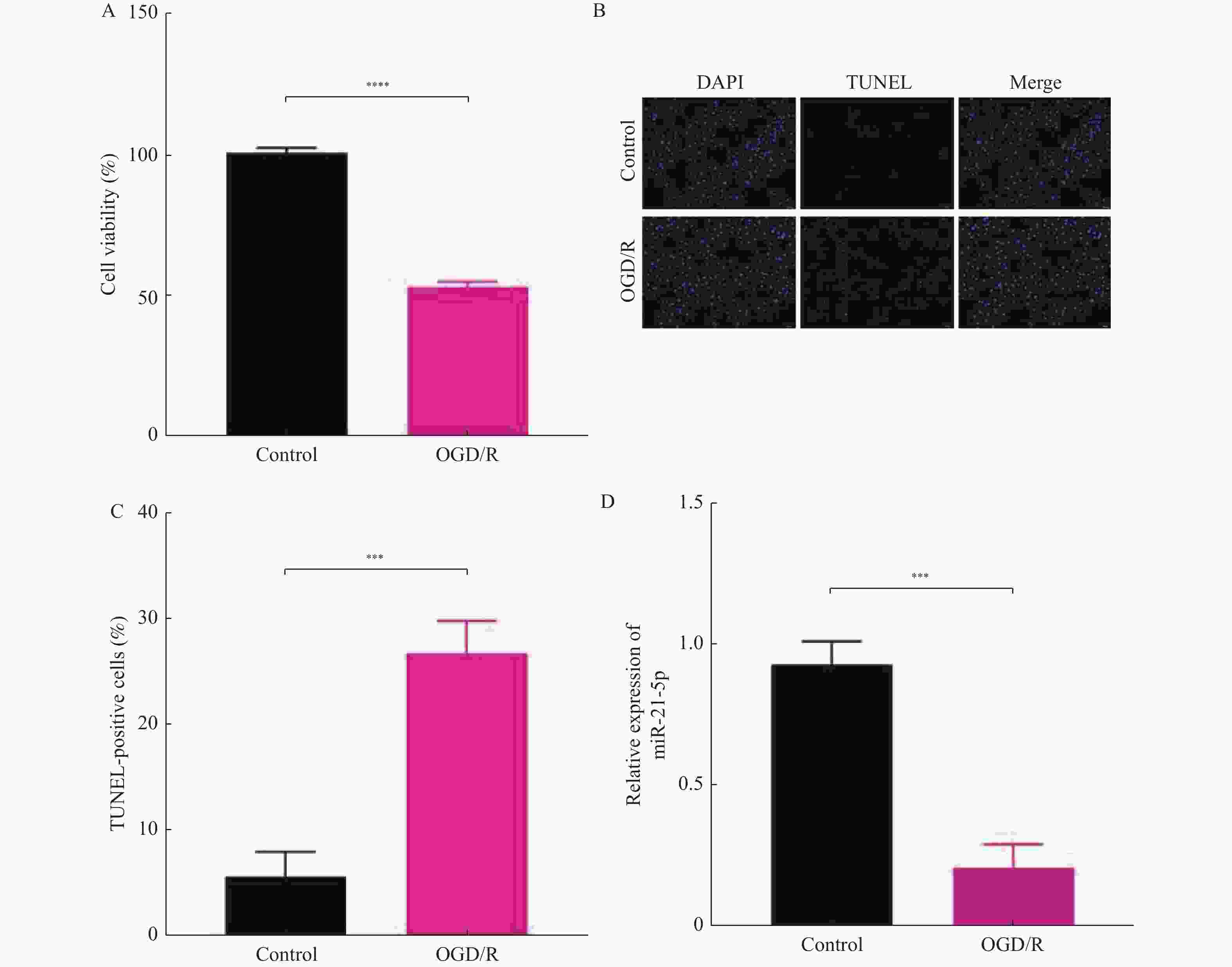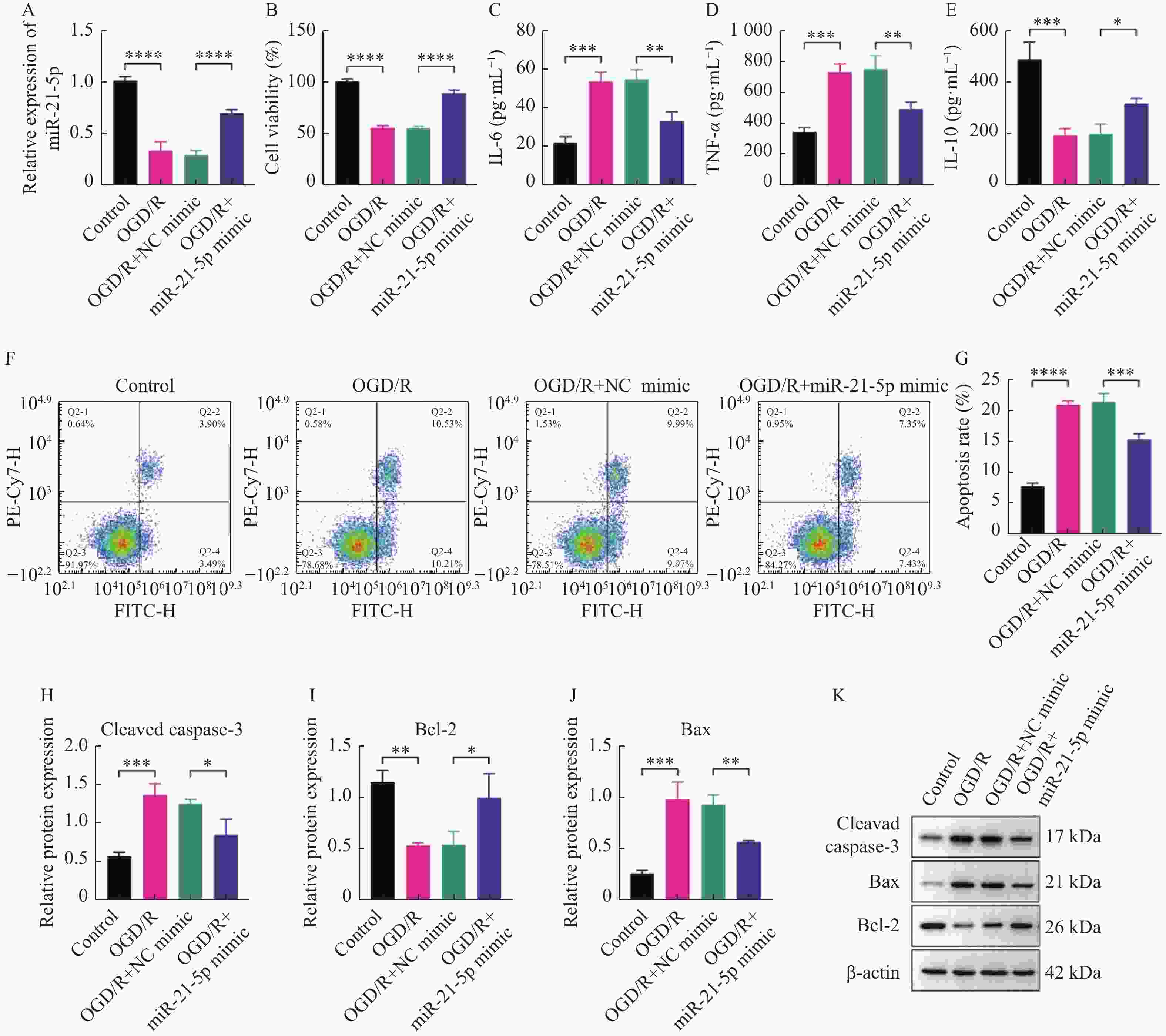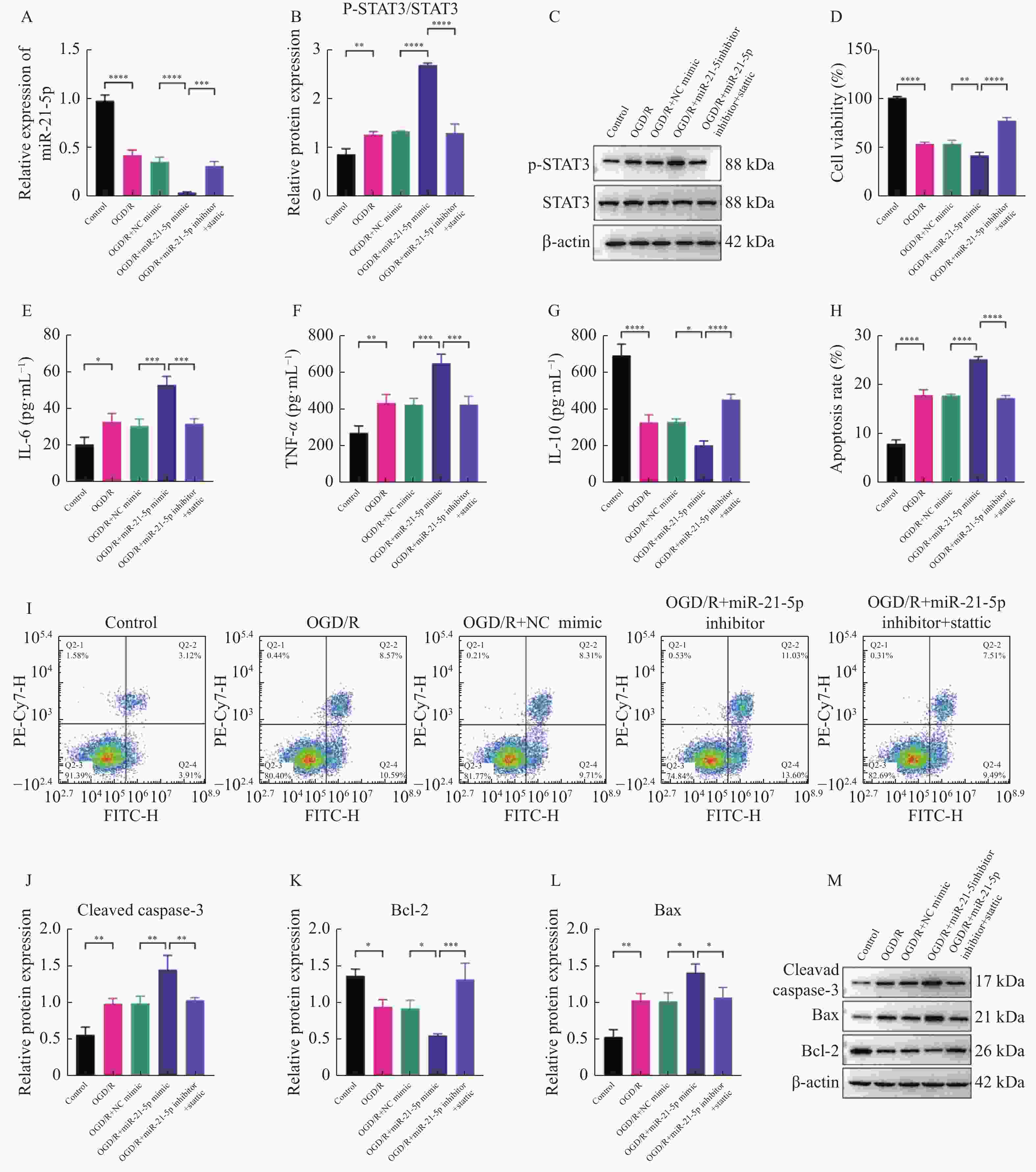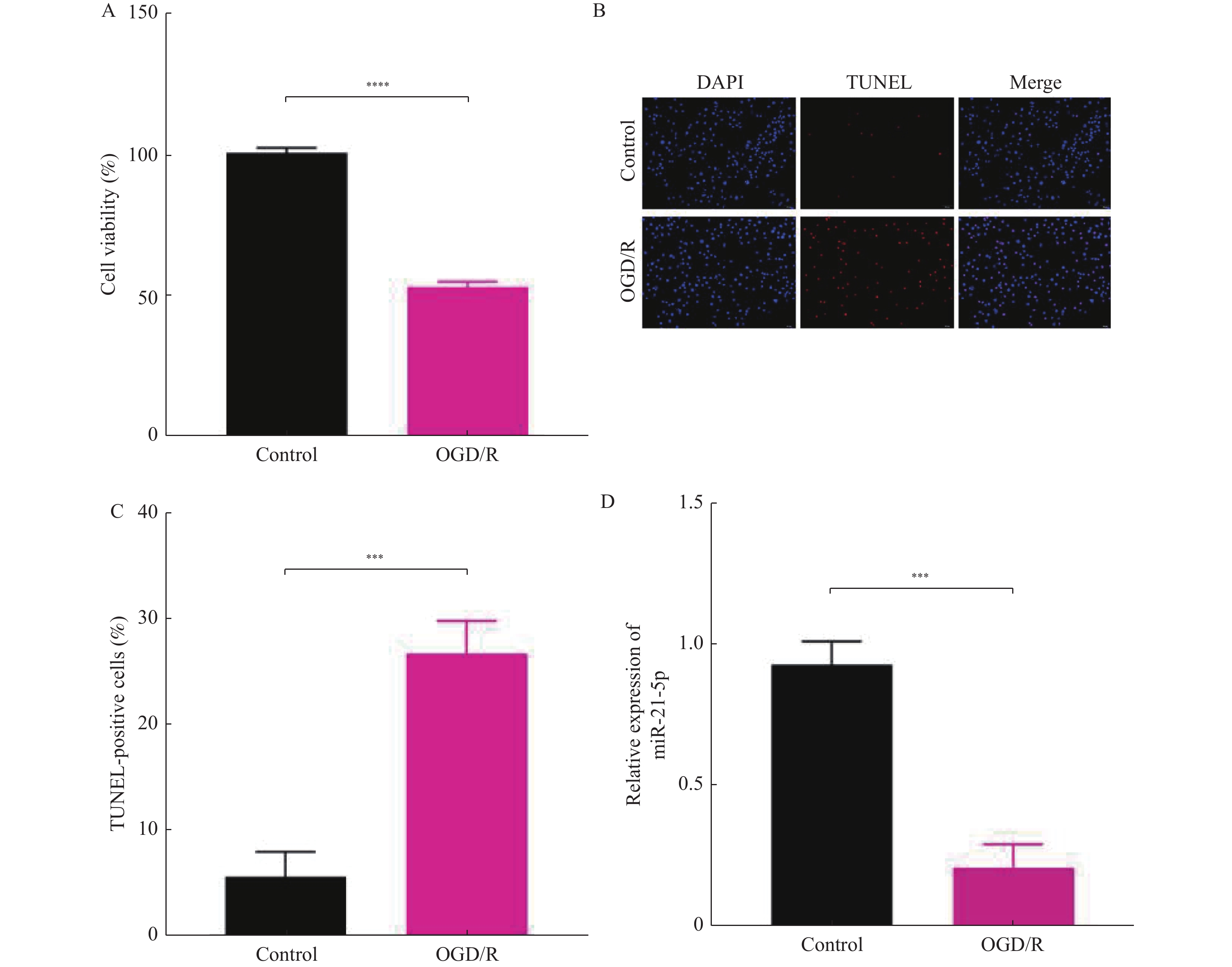miR-21-5p Targetes STAT3 Reduce the OGD/R-induced Neuronal Injury
-
摘要:
目的 探讨miR-21-5p对OGD/R诱导的HT22细胞损伤的保护作用和潜在机制。 方法 OGD/R诱导HT22细胞构建脑缺血再灌注损伤(cerebral ischemia reperfusion injury,CIRI)细胞模型。RT-qPCR检测miR-21-5p的表达。CCK-8法、TUNEL染色和流式细胞术分别检测细胞活力和细胞凋亡情况。ELISA检测细胞上清液中炎症因子IL-6、IL-10、TNF-α的含量。Western blot检测p-STAT3/STAT3、Cleaved-Caspase-3、Bax和Bcl-2蛋白的表达情况。TargetScan数据库预测miR-21-5p和STAT3的结合位点,双荧光素酶报告基因实验验证miR-21-5p与STAT3的靶向关系。 结果 miR-21-5p的表达水平在OGD/R诱导的HT22细胞中表达下调(P < 0.001)。OGD/R诱导后HT22细胞增殖活力下降(P < 0.0001 );细胞凋亡率升高(P < 0.001);促炎因子IL-6(P < 0.001)和TNF-α(P < 0.001)的含量升高,抑炎因子IL-10(P < 0.001)含量减少;miR-21-5p mimic转染后提高了细胞活力、减少了凋亡率、抑制了神经炎症。miR-21-5p能够靶向结合STAT3。miR-21-5p inhibitor转染后降低了细胞活力、促进了细胞凋亡和神经炎症的发生,STAT3抑制剂Stattic能够逆转miR-21-5p inhibitor的作用。结论 miR-21-5p能够靶向结合STAT3,减少OGD/R诱导的HT22细胞的神经炎症和细胞凋亡。 Abstract:Objective To investigate the potential mechanism of miR-21-5p in alleviating cerebral ischemia-reperfusion injury by targeting STAT3. Methods The HT22 cells were induced by OGD/R to construct a cell model of cerebral ischemia reperfusion injury. The expression of miR-21-5p was detected by RT-qPCR. The CCK-8 assay, TUNEL staining and flow cytometry were respectively used to detect the cell viability and apoptosis. ELISA assay was used to determine the contents of inflammatory factors IL-6, IL-10 and TNF-α in the cell supernatant. Western blot was used to detect the expression levels of p-STAT3/STAT3, Cleaved-Caspase-3, Bax and Bcl-2 proteins. The TargetScan database was used to predict the binding sites of miR-21-5p and STAT3. The dual-luciferase reporter gene assay was used to verify the targeting relationship between miR-21-5p and STAT3. Results The relative expression level of miR-21-5p was down-regulated in HT22 cells which induced by OGD/R (P < 0.001). The cell viability (P < 0.0001 ) was decreased and the apoptosis rate (P < 0.001) was increased in OGD/R induced-HT22 cells. The contents of pro-inflammatory factors IL-6 (P < 0.001) and TNF-α (P < 0.001) was increased, while the content of anti-inflammatory factor IL-10 (P < 0.001) decreased. After transfection with miR-21-5p mimic, cell viability was enhanced, apoptosis rate was reduced and neuroinflammation was inhibited. MiR-21-5p could target and bind to STAT3. After miR-21-5p inhibitor transfection, cell viability decreased, apoptosis was promoted, and neuroinflammation occurred; STAT3 inhibitor Stattic could reverse the effect of miR-21-5p inhibitor.Conclusion MiR-21-5p could specifically bind to STAT3 and reduce the neuroinflammation and apoptosis of OGD/R induced-HT22 cells. -
图 2 miR-21-5p mimic对OGD/R诱导的HT22细胞的影响
A:RT-qPCR检测miR-21-5p的表达情况;B:CCK-8试剂盒检测细胞活力;C~E:ELISA试剂盒检测炎症因子IL-6、TNF-α、IL-10的含量;F-G:流式细胞术检测细胞凋亡情况;H-K:Western blot检测凋亡相关蛋白Cleaved-Caspase-3、Bax和Bcl-2的表达情况;*P < 0.05,**P < 0.01,***P < 0.001,****P < 0.0001。
Figure 2. Effect of miR-21-5p mimic on OGD/R-induced HT22 cells
表 1 基因名称及引物序列
Table 1. Gene name and primer sequence
基因 引物序列 (F:正向引物;R:反向引物) (5'-3') miR-21-5p F:TCGCTCGAGATTTTTTTTTATCAAGAGGG
R:TCGGCGGCCGCGACAAGAATGAGACTTTAATCU6 F:GCTTCGGCAGCACATATAAAAT
R:CGCTTCACGAATTTGCGTGTCAT -
[1] Feske S K. Ischemic Stroke[J]. The American Journal of Medicine,2021,134(12):1457-1464. doi: 10.1016/j.amjmed.2021.07.027 [2] Jiang L,Hu X. Positive Effect of α-Asaronol on the Incidence of Post-Stroke Epilepsy for Rat with Cerebral Ischemia-Reperfusion Injury[J]. Molecules,2022,27(6):1984-1993. doi: 10.3390/molecules27061984 [3] Wang W,Liu X,Yang Z,et al. Levodopa improves cognitive function and the deficits of structural synaptic plasticity in hippocampus induced by global cerebral ischemia/reperfusion injury in rats[J]. Frontiers in Neuroscience,2020,14(1):586321. doi: 10.3389/fnins.2020.586321 [4] Mok V C T,Lam B Y K,Wang Z,et al. Delayed-onset dementia after stroke or transient ischemic attack[J]. Alzheimer's & Dementia,2016,12(11):1167-1176. [5] Di Y,Lei Y,Yu F,et al. MicroRNAs Expression and function in cerebral ischemia reperfusion injury[J]. Journal of Molecular Neuroscience,2014,53(2):242-250. doi: 10.1007/s12031-014-0293-8 [6] Neag M A,Mitre A O,Burlacu C C,et al. miRNA involvement in cerebral ischemia-reperfusion injury[J]. Frontiers in Neuroscience,2022,16(1):901360. doi: 10.3389/fnins.2022.901360 [7] Jin F,Jin L,Wei B,et al. miR-96-5p alleviates cerebral ischemia-reperfusion injury in mice by inhibiting pyroptosis via downregulating caspase 1[J]. Experimental Neurology,2024,374(1):114676. doi: 10.1016/j.expneurol.2024.114676 [8] Zhou F,Wang Y K,Zhang C G,et al. miR-19a/b-3p promotes inflammation during cerebral ischemia/reperfusion injury via SIRT1/FoxO3/SPHK1 pathway[J]. Journal of Neuroinflammation,2021,18(1):122-134. doi: 10.1186/s12974-021-02172-5 [9] Liu X,Xin W,Lijuan Z,et al. By targeting apoptosis facilitator BCL2L13,microRNA miR-484 alleviates cerebral ischemia/reperfusion injury-induced neuronal apoptosis in mice[J]. Bioengineered,2021,12(1):948-959. doi: 10.1080/21655979.2021.1898134 [10] Zhou H,Zhou J,Teng H,et al. MiR-145 enriched exosomes derived from bone marrow-derived mesenchymal stem cells protects against cerebral ischemia-reperfusion injury through downregulation of FOXO1[J]. Biochemical and Biophysical Research Communications,2022,632(1):92-99. doi: 10.1016/j.bbrc.2022.09.089 [11] O'Connell R M,Rao D S,Chaudhuri A A,et al. Physiological and pathological roles for microRNAs in the immune system[J]. Nature Reviews Immunology,2010,10(2):111-122. doi: 10.1038/nri2708 [12] Ghorbanmehr N,Gharbi S,Korsching E,et al. miR-21-5p,miR-141-3p,and miR-205-5p levels in urine—promising biomarkers for the identification of prostate and bladder cancer[J]. The Prostate,2019,79(1):88-95. doi: 10.1002/pros.23714 [13] Zhan L,Mu Z,Jiang H,et al. MiR-21-5p protects against ischemic stroke by targeting IL-6R[J]. Ann Transl Med,2023,11(2):101-116. doi: 10.21037/atm-22-6451 [14] L L,X W,Z Y. Ischemia-reperfusion injury in the brain: Mechanisms and potential therapeutic strategies[J]. Biochem Pharmacol (Los Angel),2016,5(4):213-228. [15] Pluta R,Januszewski S,Czuczwar S J. Neuroinflammation in post-ischemic neurodegeneration of the brain: Friend,foe,or both?[J]. International Journal of Molecular Sciences,2021,22(9):4405. doi: 10.3390/ijms22094405 [16] Zhang W,Shu L. Upregulation of miR-21 by ghrelin ameliorates ischemia/reperfusion-induced acute kidney injury by inhibiting inflammation and cell apoptosis[J]. DNA Cell Biol,2016,35(8):417-425. doi: 10.1089/dna.2016.3231 [17] Zhao Y,Lv R,He Y,et al. The miR-21-5p/DUSP8/MAPK signaling pathway mediates inflammation and apoptosis in vascular endothelial cells induced by intermittent hypoxia and contributes to the protective effects of N-acetylcysteine[J]. European Journal of Pharmacology,2025,997(1):177462. doi: 10.1016/j.ejphar.2025.177462 [18] Ge X,Han Z,Chen F,et al. miR-21 alleviates secondary blood–brain barrier damage after traumatic brain injury in rats[J]. Brain Research,2015,1603(1):150-157. doi: 10.1016/j.brainres.2015.01.009 [19] Ge X T,Lei P,Wang H C,et al. miR-21 improves the neurological outcome after traumatic brain injury in rats[J]. Scientific Reports,2014,4(1):6718. doi: 10.1038/srep06718 [20] Pang Q,Zhao Y,Chen X,et al. Apigenin protects the brain against ischemia/reperfusion injury via caveolin-1/VEGF in vitro and in vivo[J]. Oxidative Medicine and Cellular Longevity,2018,2018(1):7017204. doi: 10.1155/2018/7017204 [21] Wu L,Jiang C,Kang Y,et al. Curcumin exerts protective effects against hypoxia‑reoxygenation injury via the enhancement of apurinic/apyrimidinic endonuclease 1 in SH‑SY5Y cells: Involvement of the PI3K/AKT pathway[J]. Int J Mol Med,2020,45(4):993-1004. [22] Wang G Y,Wang T Z,Zhang Y Y,et al. NMMHC IIA inhibition ameliorates cerebral ischemic/reperfusion-induced neuronal apoptosis through caspase-3/ROCK1/MLC pathway[J]. Drug Design,Development and Therapy,2020,14(1):13-25. [23] Mokhtari Sangdehi S R,Akbar H M,and Ranjbar M. Anti-apoptotic effect of silymarin-loaded chitosan nanoparticles on hippocampal caspase-3 and Bcl-2 expression following cerebral ischemia/reperfusion injury[J]. International Journal of Neuroscience,2022,132(11):1102-1109. doi: 10.1080/00207454.2020.1860971 [24] Xu F,Ma R,Zhang G,et al. Estrogen and propofol combination therapy inhibits endoplasmic reticulum stress and remarkably attenuates cerebral ischemia-reperfusion injury and OGD injury in hippocampus[J]. Biomedicine & Pharmacotherapy,2018,108(1):1596-1606. [25] Teertam S K,Jha S,Prakash babu P. Up-regulation of Sirt1/miR-149-5p signaling may play a role in resveratrol induced protection against ischemia via p53 in rat brain[J]. Journal of Clinical Neuroscience,2020,72:402-411. doi: 10.1016/j.jocn.2019.11.043 [26] Shanmugam M K,Lee J H,Chai E Z P,et al. Cancer prevention and therapy through the modulation of transcription factors by bioactive natural compounds[J]. Seminars in Cancer Biology,2016,40-41(1):35-47. doi: 10.1016/j.semcancer.2016.03.005 [27] Zhong Z,Wen Z,Darnell J E. Stat3: A STAT family member activated by tyrosine phosphorylation in response to epidermal growth factor and interleukin-6[J]. Science,1994,264(5155):95-98. doi: 10.1126/science.8140422 [28] You L,Zhanggui W,Hongsen L,et al. The role of STAT3 in autophagy[J]. Autophagy,2015,11(5):729-739. doi: 10.1080/15548627.2015.1017192 -






 下载:
下载:





